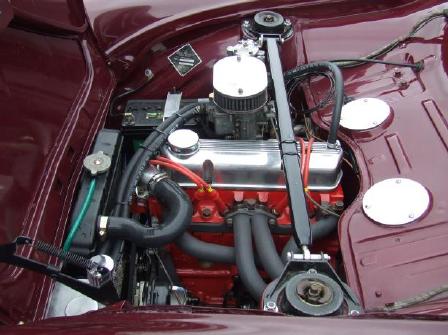The “All New Ford Anglia 105E” of 1959 not only had an attractive, new and unique body style, it also sported a new four cylinder overhead valve (OHV) type engine with a cast iron cylinder head and block. This new engine finally allowed Ford to break away from the old side valve units, which had powered the previous 100E small car range.
The Anglia 105E Engine featured overhead valves and “over-square” dimensions with bore and stroke measurements of 80.963mm x 48.412mm respectively. The new engine had a cubic capacity of 996.6cc and developed 39bhp at 5000 rpm, which pushed the new Anglia along at a respectable speed for 1959.

Specifications of the 997cc and 1198cc Engines.
| 997 cc engine | |
|---|---|
| Type | 4-cylinder in line overhead valve type |
| Bore | 3.1875 in (80.963 mm) |
| Stroke | 1.906 in (48.412 mm) |
| Cubic Capacity | 60.84 cu in (996.6 cc) |
| Compression Ratio | 8.9 to 1 Standard. For Premium Grade Fuel 7.5 to 1 Optional. For Regular Grade Fuel |
| Cylinder Head | Detachable cast iron type. Fully machined combustion chambers. |
| Valves | Vertical overhead type, push rod operated |
| Valve Clearance | 0.010 in (0.254 mm) inlet 0.017 in (0.432 mm) exhaust Normal running temperature |
| Firing Order | 1, 2, 4, 3 |
| Maximum Brake Horse Power | 39 at 5,000 RPM (8.9 C.R) |
| (Nett) | 37 at 5,000 RPM (7.5 C.R) |
| Maximum Torque | 52.85 lb ft at 2,700 RPM (8.9 C.R) |
| (Nett) | 50.43 lb ft at 2,700 RPM (7.5 C.R) |
| 1198 cc engine | |
|---|---|
| Type | 4-cylinder in line overhead valve type |
| Bore | 3.1875 in (80.963 mm) |
| Stroke | 2.29 in (58.17 mm) |
| Cubic Capacity | 73.09 cu in (1,198 cc) |
| Compression Ratio | 8.7 to 1 Standard. For Premium Grade Fuel 7.3 to 1 Optional. For Regular Grade Fuel |
| Cylinder Head | Detachable cast iron type. Fully machined combustion chambers. |
| Valves | Vertical overhead type, push rod operated |
| Valve Clearance | 0.010 in (0.254 mm) inlet 0.017 in (0.432 mm) exhaust Normal running temperature |
| Firing Order | 1, 2, 4, 3 |
| Maximum Brake Horse Power | 48.5 at 4,800 RPM (8.7 C.R) |
| (Nett) | 46 at 4,800 RPM (7.3 C.R) |
| Maximum Torque | 63 lb ft at 2,700 RPM (8.7 C.R) |
| (Nett) | 60 lb ft at 2,700 RPM (7.3 C.R) |
By continuing along this path, Ford extended the stroke even more to create the 1340cc and 1500cc engines, which would ultimately be used in its new car range at the time.
The engine is now referred to as the pre-crossflow, to differentiate it from the later crossflow engines used in the Anglia’s successor, the Escort. The names refer to the location of the inlet and exhaust manifold on each engine.. The 105E Engine or pre-crossflow, have both the inlet and exhaust manifolds on the same side, whereas the crossflow has the inlet and exhaust manifolds on opposite sides of the engine.

The Ford Anglia 105E Engine was used in various “Specials” as a means of motive power for different car manufacturers.
The Ford Anglia 105E Engine was also marinised by various Companies and used as inboard motors to power motor cruisers and riverboats.

